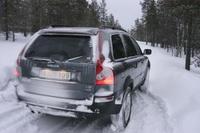Secret winter testing designs cars to cope with arctic weather
 With snow and a severe winter facing the UK, it is reassuring to know car manufacturers test and develop new cars to cope with much worse conditions, such as Volvo's secret winter test world in a snow-bound venue north of the Arctic Circle.
With snow and a severe winter facing the UK, it is reassuring to know car manufacturers test and develop new cars to cope with much worse conditions, such as Volvo's secret winter test world in a snow-bound venue north of the Arctic Circle. This is where all new Volvo models are made to suffer and are tested to extremes during the Swedish winter season’s toughest imaginable climatic conditions to ensure all controls, and heating and ventilation systems work quickly and effectively – and therefore cope easily with even the worst UK winters.
Over the whole of the northernmost part of Sweden – known as Lapland – Laplanders have learnt to survive and adapt to the harsh conditions of nature. Volvo has a long established winter test programme in Lapland, with a technically advanced laboratory facility north of the Arctic Circle, with secret field tests undertaken in different locations.
Test drivers punish new cars for thousands of miles on the extremely difficult road conditions, and skilfully avoid herds of reindeer or elk that frequently appear. The test drivers act as normal motorists and subjectively register their impressions, while at the same time, computers and a host of other technologies measure all things mechanical and electrical.
Cold starts down to minus 30 degrees are an everyday occurrence in Lapland. Everything is cold. Instruments react more slowly, clutch and gear changing become sluggish, during which the heating systems are carefully monitored, and the braking, traction control and four-wheel drive systems are continually put through their paces in slippery conditions, on and off road. Quality details, such as sunroofs, door locks or any squeaks can also be scrutinised in the severe cold.
"We try to discover faults or shortcomings at the prototype stage so that we can rectify them before production starts," says Volvo's Anders Polheimer, project manager for the Arctic field tests. "It is really important that the car functions under the extreme conditions here, as people expect a Swedish Volvo to be able to cope with the most sever winter conditions," he continued.
Snow and spray are a traffic problem in all winter environments – whether in Northern Scandinavia or on the M25 - and create the risk of accidents due to poor visibility and could cause operational problems for the driver and car. For example, driving behind another car in dense snow spray is blinding and could also cause engine problems with blocked air filters or iced-up electrical components. For Volvo, a heating system that quickly defrosts and clears a windscreen, and the option of heated seats, are essentials, not luxuries.
This is only part of the testing Volvo cars are put through in their development. A modern, premium brand car must be able to function perfectly in both the bitter cold and the burning desert sun or suffocating dust, which is why Volvo also has a secret proving ground in the Arizona desert – but that's another story…

